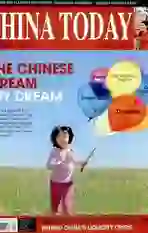Stefanie Thiedig: Artistic Opportunities
2013-04-29BystaffreporterVERENAMENZEL
By staff reporter VERENA MENZEL
FIVE years ago, Stefanie Thiedig came from northern Germany to Beijing to establish a multi-language website “Kulturgut” – a platform to promote modern Chinese art and culture as well as for freelance creative artists to communicate with each other.
“Here in China, I can work as freely as in Germany but with more opportunities to develop myself,” Stefanie said.
One day in J une, I met Stefanie, now 33, in her apartment along Beijings Second Ring Road. The abode also serves as the control center of the “Kulturgut” website. In China, where everyone is talking about the “Chinese Dream,” Stefanie has already achieved what many others only imagine.“I feel that I am doing something meaningful and on top of that, I enjoy what I do to earn a living.”
For the past five years, Stefanie has been working for the Goethe Institute in Beijing as well as at various freelance jobs to promote cultural exchange. “As Chinas cultural capital, Beijing provides me with a diverse and inspiring environment,” she said.
Stefanie studied Chinese and German at the University of Hamburg. She especially likes literature from the Ming and Qing dynasties (1368-1911). Her masters thesis was about A Dream of Red Mansions, the classic 18th-century Chinese novel.
“After graduation I wanted to continue researching modern Chinese literature, but I realized that my reading speed in Chinese was too slow,” she admitted. Therefore, she began to engage more in visual arts, photography and film, which opened new windows for her to soak up Chinese culture.
In 2009, under the concept of “translating culture”through the platform of the Kulturgut website, Stefanie began writing articles, launching research, and organizing seminars and training programs to provide new perspectives for other Germans to discover Chinese culture. She also promotes communication between German and Chinese artists to expand both sides horizons.
In 2009, Stefanie joined Katharina Schneider-Roos in co-editing the book Chinas Cultural Scene from 2000, the content of which covers fields from contemporary Chinese painting, film and photography, literature, publishing, theater, and dance to music and architecture.
Earlier this year, Stefanie organized a 10-day group tour and invited artists from Germany to visit galleries and artists studios in Beijing, Shanghai and Hangzhou where they could communicate with their Chinese counterparts. The tour enlightened the German visitors on the latest developments in Chinese art circles.
“Today, most Germans know little about Chinese modern art,” Stefanie said. “Many foreign journalists in Beijing only focus on politics and economics, so few reports in German media cover culture and art. So, I provide free information to readers through my blog, which has become a platform for building cooperation and communication. I want the content to be selective and subjective. That is very important.”
In this way she successfully built another bridge to China, which she considers her second home.
Stefanie hopes to continue promoting cultural dialogue between China and Germany through art. She regularly contributes her own ideas to institutions such as the Goethe Institute, the German Embassy and the German Society for International Cooperation (GIZ).
Her latest project is compiling a photo album with text and captions on the theme of “kitsch artwork.” Supplementing it will be photo exhibitions and the release of video products.
“I want to introduce a charming China to my countrymen through my own experience to balance the reports in my home country that often portray it as dark and ugly,” Stefanie said.
“Of course here in China I see all sorts of problems and conflicts, but for me, the idea of everyone needing an enemy only implies a lack of self-confidence.”
